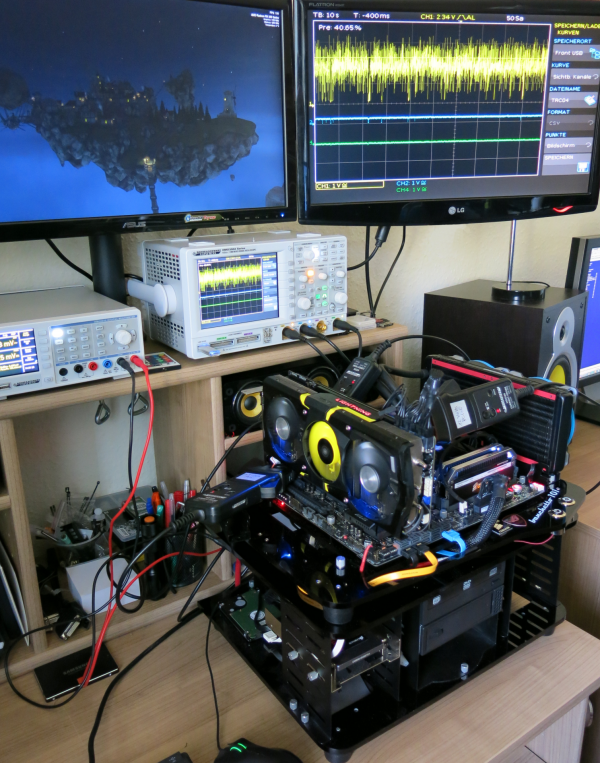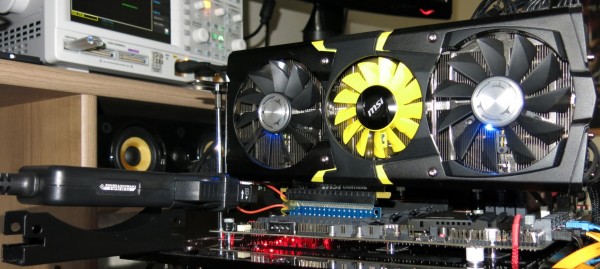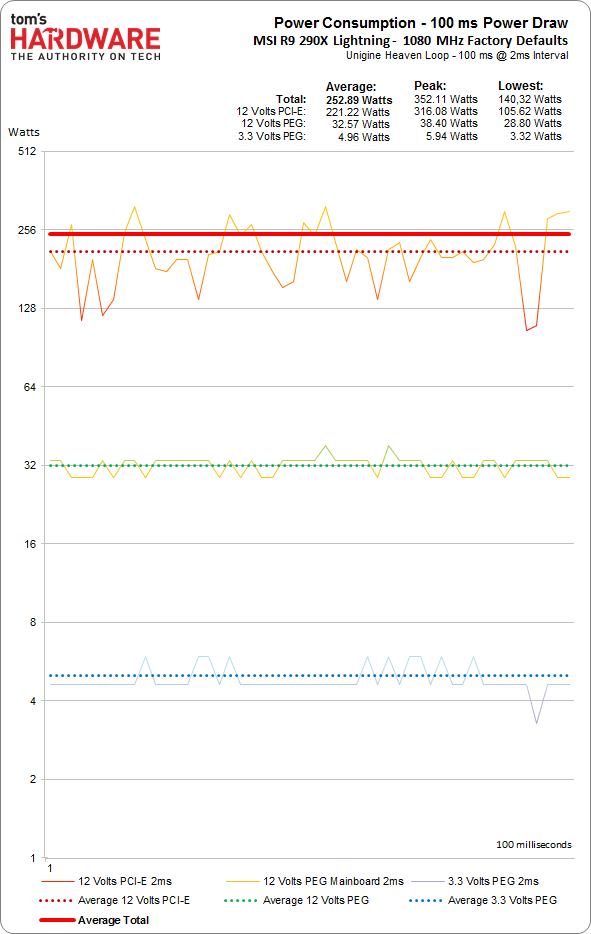MSI R9 290X Lightning Review: The Right Way To Cool Hawaii
Judging from the R9 290X Lightning's hefty build, it takes a lot of metal to cool the Hawaii GPU properly. But what does this massive card give you aside from sharp looks? How about impressive acoustics? Is its $750 price tag worth the premium experience?
Power Draw: Test System And Methods
Test System and Power Draw Measurement
We partnered up with HAMEG Instruments (Rohde & Schwarz) to implement a state-of-the-art test system for precise, short interval power and performance measurements.
Only modern lab instruments can keep up with the challenges that AMD’s Power Tune and Nvidia’s GPU Boost present (namely, huge swings in dynamic power consumption). We feed all relevant currents and voltages into a multi-channel 500 MHz oscilloscope (HAMEG HMO 3054), which can be remote-controlled and is able to retain the test data.
We measure the currents with three calibrated DC current clamp probes (HAMEG HZO50). Two of them, 3.3 and 12 V, take their readings at a custom-made riser card, which can reliably pass PCIe 3.0 signals, and one of them at a specially-modified PCIe power cable. All voltages are measured at the single-rail power supply, which we slightly modified to allow better access.
Our time resolution is now a mere 2 ms, which can measure and log all load transients incurred by AMD’s Power Tune and Nvidia’s GPU Boost. In order to keep the volume of data manageable, we limit the duration of a test run to two minutes.
| Test Method | No contact current measurement at the PCIe slot (Riser card) No contact current measurement at the external PCIe power cable Voltage measurement at the PSU |
|---|---|
| Test Equipment | 1 x HAMEG HMO 3054, 500 MHz four-channel oscilloscope 3 x HAMEG HZO50 current probe (1 mA - 30 A, 100 kHz, DC) 4 x HAMEG HZ355 (10:1 probe, 500 MHz) 1 x HAMEG HMC 8012 DSO |
| Test Bench | Microcool Banchetto 101 |
| Power Supply | Corsair AX860i with slightly modified connectors |
What Happens Within 100 ms?
A lot! We log the power draw with three probes at a 2 ms interval and pick a representative 100 ms window. Then we plot the resulting 50 data points in a graph.
Looking at the graph, you almost have to feel sorry for the power supply. Power draw through the PCIe power cables jumps from 140 to 352 W within a few milliseconds. You can't expect just any old generic PSU to cope with that. The two test points at the PCIe riser cards do not exhibit such drastic load changes.
We like that neither AMD nor Nvidia max out the PCIe slot connector's output rating, which is 75 W. Those auxiliary power cables bear the brunt of the load. Nor are there drastic load transients on the motherboard connector. All of this helps ensure system stability, benefiting multi-GPU setups in particular.
Get Tom's Hardware's best news and in-depth reviews, straight to your inbox.
Now let's take a look at power consumption in real-world workloads.
Current page: Power Draw: Test System And Methods
Prev Page Gaming Performance Next Page Power Draw: Gaming, Web Browsing, And Idle
Igor Wallossek wrote a wide variety of hardware articles for Tom's Hardware, with a strong focus on technical analysis and in-depth reviews. His contributions have spanned a broad spectrum of PC components, including GPUs, CPUs, workstations, and PC builds. His insightful articles provide readers with detailed knowledge to make informed decisions in the ever-evolving tech landscape
-
blackmagnum If it costs 750 bucks, it should come with water-cooling. Why the need to slap on a pound of metal to cool it if there was a more customer friendly way?Reply -
solix Unless I am mistaken you burn 3 slots with this guy. For how close this is to the Tri-x in thermals and acoustics, but with the loss of a slot and the added price, meh. Tri-x still seems like the best value proposition.Reply -
CaptainTom I just want to point out how silly the 780 Ti is priced. People, this card trades blows with the 780 Ti while giving you an extra GB of VRAM. It should cost at least as much as the 780 Ti. Or better yet, the other way around! ;)Reply -
AndrewJacksonZA ReplyUnfortunately, in order to increase this card's GPU voltage, you have to register with MSI for a special license. This isn't given out freely; only professional overclockers can get their hands on it.
Whoa, wait, what??? -
dscudella As of my post, the pricing on Newegg for the mentioned cards:Reply
MSI 290x Lightning $699.99 + $4.99 shipping
Sapphire 290x Tri-X OC $649.99Sapphire 290x Tri-X $639.99Gigabyte 290x Windforce $579.99 ($549.99 after rebate)
This makes the Lightning $125 ($155 after rebate) more expensive than the Windforce. MSI is really stretching the price here. -
zzzaac $899 or 841 USD where i'm from for this card. Got to admit though, 3 slot cards are really unappealing for me.Reply
Got to agree that the Tri-X seems a better value proposition
-
cats_Paw A bit useless review:Reply
The main aspect of a GPU and its most important job is to make games run smooth.
In this review there is only a Performance ratio chart. This does not give the important data at all.
I dont care if that GPU has 80 or 85 FPS in farcry3, but I Do care if it has 25 or 30 on more demanding games/settings.
Finally, this card seems like itsmissing its purpouse a bit.
It has a huge heatsink, but dosent actually run cool or quiet.
It has an OC that is decent but dosent increase performance that much.
You could water cool that GPU for a similar price and get better performance in every aspect as long as you are willing to have a loop in your PC.
-
redgarl Where is your review of the Powercolor PCS+ R290x...? From all the review I have seen, not only they are cheaper, but perform better I from what I am seeing, smaller.Reply -
ubercake That "Certificate of Quality and Stability" is humorous...Reply
"I hereby declare this video card to be of the utmost quality and thereby further and henceforth declare this same electronic device to be 101% stable to the fullest of my capabilities to determine it as such. Sincerely, Your Mom".
Definitely something to frame and hang on your wall above the monitor. -
ewok93 I feel like it would be much more cost effective to go with water cooling, it would definitely be much lighter. I may be wrong, though, as that heatsink is pretty freaking massive. It just seems like past a certain point, air cooling can only do so much, and can only take up so much space.Reply
If you're just going for overkill, I want to see one of these with phase change cooling. It can't cost that much more, can it?


